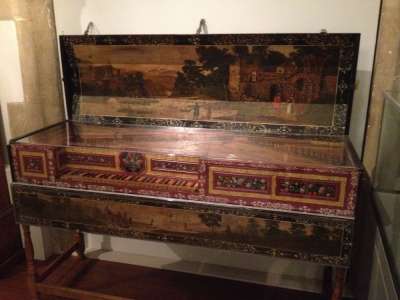Virginal
Functioning in a similar way to a harpsicord or piano, the virginal is a stringed instrument played with keys. The keys activate quills which then pluck the strings, creating a sound. Although a virginal uses the same plucking mechanism as a harpsicord, it is of a rectangular shape and its strings run parallel to the fingerboard.
Around twenty-four English virginals survive today. They represent a flourishing tradition of instrument building when English composers led the development of keyboard technique and composition. RAMM’s virginal is located in the Making Histories gallery. It was built by Charles Rewallin, a resident of St Sidwells, Exeter, in 1679. We know of only two instruments made by him which still exist.
The case of the virginal is made from pine and it sound board from spruce. The wood is over-painted with landscape scenes; flowers and fruits are arranged in small decorative fields surrounded by ornaments. Gilded paper strips decorate the front of the musical instrument on the ebony keys. Attached to a rectangular resonating body are two lids which close to cover the soundboard and the fingerboard. The instrument has fifty-two keys, fifty-six jacks and fifty-six strings.
Virginals became popular amongst young ladies who would perform with them during the musical soirées so fashionable at the time. They may derive their name from this association.
Around twenty-four English virginals survive today. They represent a flourishing tradition of instrument building when English composers led the development of keyboard technique and composition. RAMM’s virginal is located in the Making Histories gallery. It was built by Charles Rewallin, a resident of St Sidwells, Exeter, in 1679. We know of only two instruments made by him which still exist.
The case of the virginal is made from pine and it sound board from spruce. The wood is over-painted with landscape scenes; flowers and fruits are arranged in small decorative fields surrounded by ornaments. Gilded paper strips decorate the front of the musical instrument on the ebony keys. Attached to a rectangular resonating body are two lids which close to cover the soundboard and the fingerboard. The instrument has fifty-two keys, fifty-six jacks and fifty-six strings.
Virginals became popular amongst young ladies who would perform with them during the musical soirées so fashionable at the time. They may derive their name from this association.
Object Summary
- Accession Loan No.
- 22/1953
- Collection Class
- Musical instruments
- Material
- pine (painted)sprucemahoganybox and ebonypaper
- Common Name
- virginal
- Simple Name
- musical instrument
- Period Classification
- Charles II (1660-1685)
- Production Town
- Exeter
- Production County
- Devon
- Production Country
- United Kingdom: England
- Production Date
- 1679
- Production Person Initials
- Charles
- Production Person Surname
- Rewallin
- Production Year Low
- 1678
- Production Year High
- 1679


